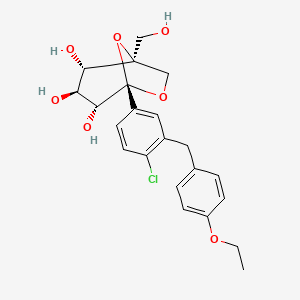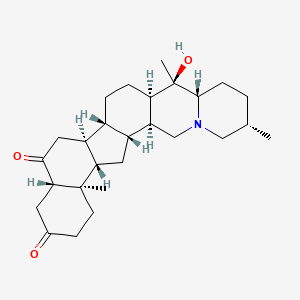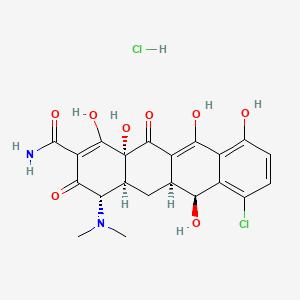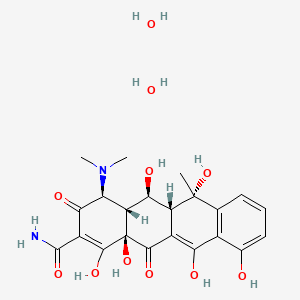
恩格列净
描述
恩格列净是一种选择性钠-葡萄糖协同转运体2 (SGLT2) 抑制剂,主要用于治疗2型糖尿病。它通过阻断肾脏中葡萄糖的重吸收起作用,从而导致尿液中葡萄糖排泄增加。 这有助于降低 2 型糖尿病患者的血糖水平 .
科学研究应用
恩格列净具有广泛的科学研究应用,特别是在化学、生物学、医学和工业领域。在医学中,它用于通过改善血糖控制来治疗 2 型糖尿病。 它还因其潜在的心血管益处而被研究,包括降低发生主要心血管事件和因心力衰竭住院的风险 . 在化学中,它用作研究 SGLT2 抑制剂的药代动力学和药效学的模型化合物 . 在工业中,它用于开发新的抗糖尿病药物和制剂 .
作用机制
恩格列净通过抑制肾脏中的钠-葡萄糖协同转运体 2 (SGLT2) 发挥作用。 这种抑制阻止了肾小球滤液中葡萄糖的重吸收,导致尿液中葡萄糖排泄增加,血葡萄糖水平降低 . 参与此过程的分子靶标包括位于肾脏近端小管中的 SGLT2 蛋白 .
生化分析
Biochemical Properties
Ertugliflozin plays a crucial role in biochemical reactions by inhibiting the sodium-glucose cotransporter 2, which is predominantly expressed in the proximal renal tubules. This inhibition prevents the reabsorption of glucose from the glomerular filtrate back into the bloodstream, thereby increasing urinary glucose excretion . Ertugliflozin interacts with several biomolecules, including the sodium-glucose cotransporter 2 protein itself. The binding of ertugliflozin to sodium-glucose cotransporter 2 is highly selective, ensuring minimal interaction with other glucose transporters .
Cellular Effects
Ertugliflozin exerts significant effects on various cell types, particularly renal tubular cells. By inhibiting sodium-glucose cotransporter 2, ertugliflozin reduces glucose reabsorption, leading to increased glucose excretion and decreased blood glucose levels . This reduction in glucose levels can influence cell signaling pathways, such as the insulin signaling pathway, and can lead to changes in gene expression related to glucose metabolism . Additionally, ertugliflozin has been shown to reduce oxidative stress and inflammation in renal cells, contributing to its protective effects on kidney function .
Molecular Mechanism
The molecular mechanism of action of ertugliflozin involves the selective inhibition of sodium-glucose cotransporter 2. Ertugliflozin binds to the sodium-glucose cotransporter 2 protein, blocking its ability to transport glucose and sodium ions across the renal tubular cell membrane . This inhibition leads to increased glucose excretion in the urine and decreased blood glucose levels. Ertugliflozin also affects the expression of genes involved in glucose metabolism and insulin signaling, further contributing to its hypoglycemic effects .
Temporal Effects in Laboratory Settings
In laboratory settings, the effects of ertugliflozin have been observed to change over time. Ertugliflozin is rapidly absorbed following oral administration, with peak plasma concentrations occurring within 1 to 2 hours . The terminal elimination half-life of ertugliflozin ranges from 11 to 18 hours, allowing for once-daily dosing . Long-term studies have shown that ertugliflozin maintains its efficacy in reducing blood glucose levels over extended periods, with minimal degradation or loss of stability . Additionally, ertugliflozin has been shown to have long-term protective effects on renal function in both in vitro and in vivo studies .
Dosage Effects in Animal Models
In animal models, the effects of ertugliflozin vary with different dosages. Studies have shown that lower doses of ertugliflozin effectively reduce blood glucose levels without causing significant adverse effects . Higher doses of ertugliflozin can lead to increased urinary glucose excretion and potential adverse effects, such as dehydration and electrolyte imbalances . Threshold effects have been observed, with a plateau in glucose-lowering effects at higher doses . Toxicity studies in animal models have shown that ertugliflozin is generally well-tolerated, with a low incidence of adverse effects at therapeutic doses .
Metabolic Pathways
Ertugliflozin is primarily metabolized through glucuronidation, mediated by the enzymes uridine 5’-diphospho-glucuronosyltransferase 1A9 and uridine 5’-diphospho-glucuronosyltransferase 2B7 . Approximately 86% of ertugliflozin is metabolized via this pathway, resulting in the formation of pharmacologically inactive glucuronide conjugates . A minor portion of ertugliflozin undergoes oxidative metabolism by cytochrome P450 3A4, contributing to about 12% of its clearance . The metabolic pathways of ertugliflozin ensure its efficient elimination from the body, with minimal accumulation of active drug .
Transport and Distribution
Ertugliflozin is rapidly absorbed following oral administration, with peak plasma concentrations occurring within 1 to 2 hours . The drug is widely distributed throughout the body, with a volume of distribution of approximately 85 liters . Ertugliflozin is highly bound to plasma proteins, primarily albumin, which facilitates its transport and distribution within the bloodstream . The primary route of elimination for ertugliflozin is through metabolism, with minimal renal excretion of the unchanged drug .
Subcellular Localization
Ertugliflozin primarily localizes to the renal proximal tubular cells, where it exerts its inhibitory effects on sodium-glucose cotransporter 2 . The drug’s localization to these cells is facilitated by its high affinity for the sodium-glucose cotransporter 2 protein, ensuring targeted inhibition of glucose reabsorption . Ertugliflozin does not undergo significant post-translational modifications or targeting signals that direct it to other cellular compartments or organelles .
准备方法
合成路线和反应条件: 恩格列净的合成涉及多个步骤,从用三苯甲基保护中间体化合物中伯醇部分开始,在吡啶存在下进行。 然后用对甲苯磺酸进行脱保护 . 该过程还涉及使用具有式 III、式 IV 和式 VII 的化合物,这些化合物用合适的保护基进行保护,以确保高纯度和高收率 .
工业生产方法: 恩格列净的工业生产遵循类似的合成路线,但规模更大。该过程涉及使用先进的技术和设备,以确保高收率和高纯度。 尽量减少使用吡啶等危险化学品,以确保安全并符合工业标准 .
化学反应分析
反应类型: 恩格列净经历各种化学反应,包括氧化、还原和取代。 它在酸性、碱性和热条件下稳定,但在光解和氧化条件下会发生明显的降解 .
常用试剂和条件: 恩格列净反应中常用的试剂包括用于脱保护的对甲苯磺酸和用于 pH 调节的正磷酸。 反应通常在受控条件下进行,以确保化合物的稳定性和纯度 .
形成的主要产物: 恩格列净反应形成的主要产物包括其代谢产物,主要通过尿液排泄。 主要的代谢途径是葡萄糖醛酸化,约占代谢的 86% .
相似化合物的比较
恩格列净是 SGLT2 抑制剂类药物的一部分,其中还包括卡格列净、达格列净和恩格列净。 与这些化合物相比,恩格列净在降低血糖水平方面显示出类似的疗效,但其安全性 and 副作用可能不同 . 例如,已发现恩格列净比其他一些 SGLT2 抑制剂导致尿路感染的风险更低 .
类似化合物列表:- 卡格列净
- 达格列净
- 恩格列净
- 贝格列净
属性
IUPAC Name |
(1S,2S,3S,4R,5S)-5-[4-chloro-3-[(4-ethoxyphenyl)methyl]phenyl]-1-(hydroxymethyl)-6,8-dioxabicyclo[3.2.1]octane-2,3,4-triol | |
|---|---|---|
| Source | PubChem | |
| URL | https://pubchem.ncbi.nlm.nih.gov | |
| Description | Data deposited in or computed by PubChem | |
InChI |
InChI=1S/C22H25ClO7/c1-2-28-16-6-3-13(4-7-16)9-14-10-15(5-8-17(14)23)22-20(27)18(25)19(26)21(11-24,30-22)12-29-22/h3-8,10,18-20,24-27H,2,9,11-12H2,1H3/t18-,19-,20+,21-,22-/m0/s1 | |
| Source | PubChem | |
| URL | https://pubchem.ncbi.nlm.nih.gov | |
| Description | Data deposited in or computed by PubChem | |
InChI Key |
MCIACXAZCBVDEE-CUUWFGFTSA-N | |
| Source | PubChem | |
| URL | https://pubchem.ncbi.nlm.nih.gov | |
| Description | Data deposited in or computed by PubChem | |
Canonical SMILES |
CCOC1=CC=C(C=C1)CC2=C(C=CC(=C2)C34C(C(C(C(O3)(CO4)CO)O)O)O)Cl | |
| Source | PubChem | |
| URL | https://pubchem.ncbi.nlm.nih.gov | |
| Description | Data deposited in or computed by PubChem | |
Isomeric SMILES |
CCOC1=CC=C(C=C1)CC2=C(C=CC(=C2)[C@@]34[C@@H]([C@H]([C@@H]([C@@](O3)(CO4)CO)O)O)O)Cl | |
| Source | PubChem | |
| URL | https://pubchem.ncbi.nlm.nih.gov | |
| Description | Data deposited in or computed by PubChem | |
Molecular Formula |
C22H25ClO7 | |
| Source | PubChem | |
| URL | https://pubchem.ncbi.nlm.nih.gov | |
| Description | Data deposited in or computed by PubChem | |
DSSTOX Substance ID |
DTXSID40153120 | |
| Record name | PF-04971729 | |
| Source | EPA DSSTox | |
| URL | https://comptox.epa.gov/dashboard/DTXSID40153120 | |
| Description | DSSTox provides a high quality public chemistry resource for supporting improved predictive toxicology. | |
Molecular Weight |
436.9 g/mol | |
| Source | PubChem | |
| URL | https://pubchem.ncbi.nlm.nih.gov | |
| Description | Data deposited in or computed by PubChem | |
Solubility |
Very slightly soluble | |
| Record name | Ertugliflozin | |
| Source | DrugBank | |
| URL | https://www.drugbank.ca/drugs/DB11827 | |
| Description | The DrugBank database is a unique bioinformatics and cheminformatics resource that combines detailed drug (i.e. chemical, pharmacological and pharmaceutical) data with comprehensive drug target (i.e. sequence, structure, and pathway) information. | |
| Explanation | Creative Common's Attribution-NonCommercial 4.0 International License (http://creativecommons.org/licenses/by-nc/4.0/legalcode) | |
Mechanism of Action |
As part of a normal process, the glucose from the blood is filtered for excretion and reabsorbed in the glomerulus so less than one percent of this glucose is excreted in the urine. The reabsorption is mediated by the sodium-dependent glucose cotransporter (SGLT), mainly the type 2 which is responsible for 90% of the reabsorbed glucose. Ertugliflozin is a small inhibitor of the SGLT2 and its activity increases glucose excretion, reducing hyperglycemia without the requirement of excessive insulin secretion. | |
| Record name | Ertugliflozin | |
| Source | DrugBank | |
| URL | https://www.drugbank.ca/drugs/DB11827 | |
| Description | The DrugBank database is a unique bioinformatics and cheminformatics resource that combines detailed drug (i.e. chemical, pharmacological and pharmaceutical) data with comprehensive drug target (i.e. sequence, structure, and pathway) information. | |
| Explanation | Creative Common's Attribution-NonCommercial 4.0 International License (http://creativecommons.org/licenses/by-nc/4.0/legalcode) | |
CAS No. |
1210344-57-2, 1431329-06-4, 1210344-83-4 | |
| Record name | Ertugliflozin | |
| Source | CAS Common Chemistry | |
| URL | https://commonchemistry.cas.org/detail?cas_rn=1210344-57-2 | |
| Description | CAS Common Chemistry is an open community resource for accessing chemical information. Nearly 500,000 chemical substances from CAS REGISTRY cover areas of community interest, including common and frequently regulated chemicals, and those relevant to high school and undergraduate chemistry classes. This chemical information, curated by our expert scientists, is provided in alignment with our mission as a division of the American Chemical Society. | |
| Explanation | The data from CAS Common Chemistry is provided under a CC-BY-NC 4.0 license, unless otherwise stated. | |
| Record name | Ertugliflozin [USAN:INN] | |
| Source | ChemIDplus | |
| URL | https://pubchem.ncbi.nlm.nih.gov/substance/?source=chemidplus&sourceid=1210344572 | |
| Description | ChemIDplus is a free, web search system that provides access to the structure and nomenclature authority files used for the identification of chemical substances cited in National Library of Medicine (NLM) databases, including the TOXNET system. | |
| Record name | Ertugliflozin | |
| Source | DrugBank | |
| URL | https://www.drugbank.ca/drugs/DB11827 | |
| Description | The DrugBank database is a unique bioinformatics and cheminformatics resource that combines detailed drug (i.e. chemical, pharmacological and pharmaceutical) data with comprehensive drug target (i.e. sequence, structure, and pathway) information. | |
| Explanation | Creative Common's Attribution-NonCommercial 4.0 International License (http://creativecommons.org/licenses/by-nc/4.0/legalcode) | |
| Record name | PF-04971729 | |
| Source | EPA DSSTox | |
| URL | https://comptox.epa.gov/dashboard/DTXSID40153120 | |
| Description | DSSTox provides a high quality public chemistry resource for supporting improved predictive toxicology. | |
| Record name | 1,6-Anhydro-1-C-[4-chloro-3-[(4-ethoxyphenyl)methyl]phenyl]-5-C-(hydroxymethyl)-beta-L-idopyranose | |
| Source | European Chemicals Agency (ECHA) | |
| URL | https://echa.europa.eu/information-on-chemicals | |
| Description | The European Chemicals Agency (ECHA) is an agency of the European Union which is the driving force among regulatory authorities in implementing the EU's groundbreaking chemicals legislation for the benefit of human health and the environment as well as for innovation and competitiveness. | |
| Explanation | Use of the information, documents and data from the ECHA website is subject to the terms and conditions of this Legal Notice, and subject to other binding limitations provided for under applicable law, the information, documents and data made available on the ECHA website may be reproduced, distributed and/or used, totally or in part, for non-commercial purposes provided that ECHA is acknowledged as the source: "Source: European Chemicals Agency, http://echa.europa.eu/". Such acknowledgement must be included in each copy of the material. ECHA permits and encourages organisations and individuals to create links to the ECHA website under the following cumulative conditions: Links can only be made to webpages that provide a link to the Legal Notice page. | |
| Record name | Ertugliflozin | |
| Source | European Chemicals Agency (ECHA) | |
| URL | https://echa.europa.eu/information-on-chemicals | |
| Description | The European Chemicals Agency (ECHA) is an agency of the European Union which is the driving force among regulatory authorities in implementing the EU's groundbreaking chemicals legislation for the benefit of human health and the environment as well as for innovation and competitiveness. | |
| Explanation | Use of the information, documents and data from the ECHA website is subject to the terms and conditions of this Legal Notice, and subject to other binding limitations provided for under applicable law, the information, documents and data made available on the ECHA website may be reproduced, distributed and/or used, totally or in part, for non-commercial purposes provided that ECHA is acknowledged as the source: "Source: European Chemicals Agency, http://echa.europa.eu/". Such acknowledgement must be included in each copy of the material. ECHA permits and encourages organisations and individuals to create links to the ECHA website under the following cumulative conditions: Links can only be made to webpages that provide a link to the Legal Notice page. | |
| Record name | Ertugliflozin | |
| Source | European Chemicals Agency (ECHA) | |
| URL | https://echa.europa.eu/information-on-chemicals | |
| Description | The European Chemicals Agency (ECHA) is an agency of the European Union which is the driving force among regulatory authorities in implementing the EU's groundbreaking chemicals legislation for the benefit of human health and the environment as well as for innovation and competitiveness. | |
| Explanation | Use of the information, documents and data from the ECHA website is subject to the terms and conditions of this Legal Notice, and subject to other binding limitations provided for under applicable law, the information, documents and data made available on the ECHA website may be reproduced, distributed and/or used, totally or in part, for non-commercial purposes provided that ECHA is acknowledged as the source: "Source: European Chemicals Agency, http://echa.europa.eu/". Such acknowledgement must be included in each copy of the material. ECHA permits and encourages organisations and individuals to create links to the ECHA website under the following cumulative conditions: Links can only be made to webpages that provide a link to the Legal Notice page. | |
| Record name | Ertugliflozin | |
| Source | FDA Global Substance Registration System (GSRS) | |
| URL | https://gsrs.ncats.nih.gov/ginas/app/beta/substances/6C282481IP | |
| Description | The FDA Global Substance Registration System (GSRS) enables the efficient and accurate exchange of information on what substances are in regulated products. Instead of relying on names, which vary across regulatory domains, countries, and regions, the GSRS knowledge base makes it possible for substances to be defined by standardized, scientific descriptions. | |
| Explanation | Unless otherwise noted, the contents of the FDA website (www.fda.gov), both text and graphics, are not copyrighted. They are in the public domain and may be republished, reprinted and otherwise used freely by anyone without the need to obtain permission from FDA. Credit to the U.S. Food and Drug Administration as the source is appreciated but not required. | |
体外研究产品的免责声明和信息
请注意,BenchChem 上展示的所有文章和产品信息仅供信息参考。 BenchChem 上可购买的产品专为体外研究设计,这些研究在生物体外进行。体外研究,源自拉丁语 "in glass",涉及在受控实验室环境中使用细胞或组织进行的实验。重要的是要注意,这些产品没有被归类为药物或药品,他们没有得到 FDA 的批准,用于预防、治疗或治愈任何医疗状况、疾病或疾病。我们必须强调,将这些产品以任何形式引入人类或动物的身体都是法律严格禁止的。遵守这些指南对确保研究和实验的法律和道德标准的符合性至关重要。


![(3As,4r,10as)-2,6-diamino-10,10-dihydroxy-4-(hydroxymethyl)-3a,4,9,10-tetrahydro-3h,8h-pyrrolo[1,2-c]purin-9-yl hydrogen sulfate](/img/structure/B560001.png)













